| 编辑推荐: |
| 本文来自于jdon,本文主要介绍了Netty是什么,使用Netty建立一个服务器的代码演示等内容
,希望对您能有所帮助。 |
|
Netty是一个高性能 事件驱动的异步的非堵塞的IO(NIO)框架,用于建立TCP等底层的连接,基于Netty可以建立高性能的Http服务器。支持HTTP、
WebSocket 、Protobuf、 Binary TCP |和UDP,Netty已经被很多高性能项目作为其Socket底层基础,如HornetQ
Infinispan Vert.x
Play Framework Finangle和 Cassandra。其竞争对手是:Apache MINA和
Grizzly。
传统堵塞的IO读取如下:
InputStream
is = new FileInputStream("input.bin");
int byte = is.read(); // 当前线程等待结果到达直至错误 |
而使用NIO如下:
while (true)
{
selector.select(); // 从多个通道请求事件
Iterator it = selector.selectedKeys().iterator();
while (it.hasNext()) {
SelectorKey key = (SelectionKey) it.next();
handleKey(key);
it.remove();
}
} |
堵塞与非堵塞原理
传统硬件的堵塞如下,从内存中读取数据,然后写到磁盘,而CPU一直等到磁盘写完成,磁盘的写操作是慢的,这段时间CPU被堵塞不能发挥效率。
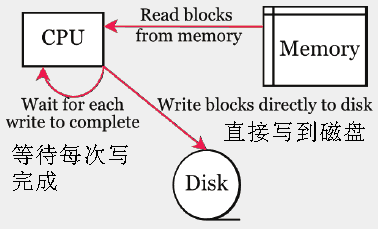
使用非堵塞的DMA如下图:CPU只是发出写操作这样的指令,做一些初始化工作,DMA具体执行,从内存中读取数据,然后写到磁盘,当完成写后发出一个中断事件给CPU。这段时间CPU是空闲的,可以做别的事情。这个原理称为Zero.copy零拷贝。
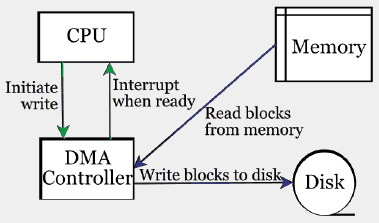
Netty底层基于上述Java NIO的零拷贝原理实现:
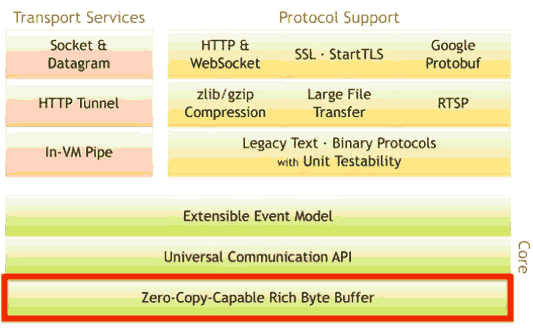
比较
Tomcat是一个Web服务器,它是采取一个请求一个线程,当有1000客户端时,会耗费很多内存。通常一个线程将花费
256kb到1mb的stack空间。
Node.js是一个线程服务于所有请求,在错误处理上有限制
Netty是一个线程服务于很多请求,如下图,当从Java NIO获得一个Selector事件,将激活通道Channel。
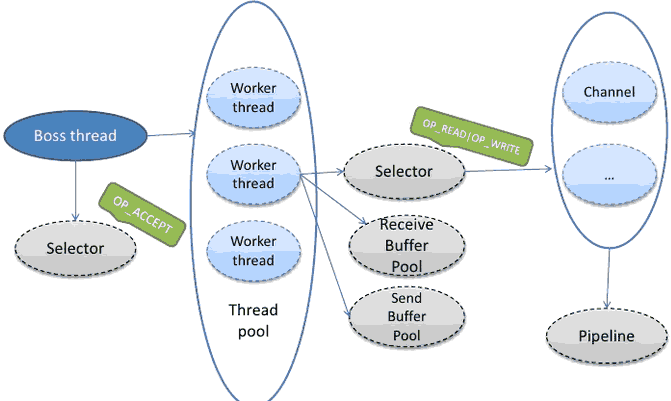
演示
Netty的使用代码如下:
Channel channel
= ...
ChannelFuture cf = channel.write(data);
cf.addListener(
new ChannelFutureListener() {
@Override
public void operationComplete(ChannelFuture
future) throws Exception {
if(!future.isSuccess() {
future.cause().printStacktrace();
...
}
...
}
});
...
cf.sync(); |
通过引入观察者监听,当有数据时,将自动激活监听者中的代码运行。
我们使用Netty建立一个服务器代码:
public class
EchoServer {
private final int port;
public EchoServer(int port) {
this.port = port;
}
public void run() throws Exception {
// Configure the server.
EventLoopGroup bossGroup = new NioEventLoopGroup();
EventLoopGroup workerGroup = new NioEventLoopGroup();
try {
ServerBootstrap b = new ServerBootstrap();
b.group(bossGroup, workerGroup).channel (NioServerSocketChannel.class)
.option(ChannelOption.SO_BACKLOG, 100)
.handler(new LoggingHandler(LogLevel.INFO)).childHandler(new
ChannelInitializer<SocketChannel>() {
@Override
public void initChannel(SocketChannel ch) throws
Exception {
ch.pipeline().addLast(
// new LoggingHandler(LogLevel.INFO),
new EchoServerHandler());
}
});
// Start the server.
ChannelFuture f = b.bind(port).sync();
// Wait until the server socket is closed.
f.channel().closeFuture().sync();
} finally {
// Shut down all event loops to terminate all
threads.
bossGroup.shutdownGracefully();
workerGroup.shutdownGracefully();
}
}
} |
这段代码调用:在9999端口启动
| new EchoServer(9999).run(); |
我们需要完成的代码是EchoServerHandler:
public class
EchoServerHandler extends ChannelInboundHandlerAdapter
{
private static final Logger logger = Logger.getLogger(EchoServerHandler.class.getName());
@Override
public void channelRead(ChannelHandlerContext
ctx, Object msg) throws Exception {
ctx.write(msg);
}
@Override
public void channelReadComplete(ChannelHandlerContext
ctx) throws Exception {
ctx.flush();
}
@Override
public void exceptionCaught(ChannelHandlerContext
ctx, Throwable cause) {
// Close the connection when an exception is
raised.
logger.log(Level.WARNING, "Unexpected exception
from downstream.", cause);
ctx.close();
}
} |
原理
一个Netty服务器的原理如下:
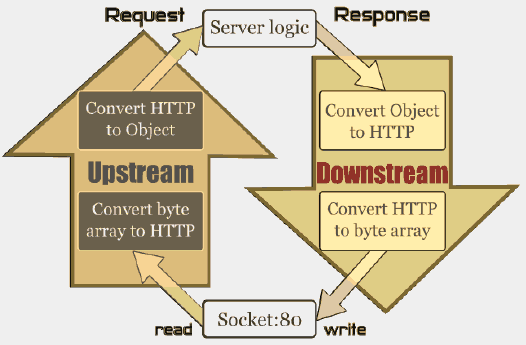
图中每次请求的读取是通过UpStream来实现,然后激活我们的服务逻辑如EchoServerHandler,而服务器向外写数据,也就是响应是通过DownStream实现的。每个通道Channel包含一对UpStream和DownStream,以及我们的handlers(EchoServerHandler),如下图,这些都是通过channel
pipeline封装起来的,数据流在管道里流动,每个Socket对应一个ChannelPipeline。
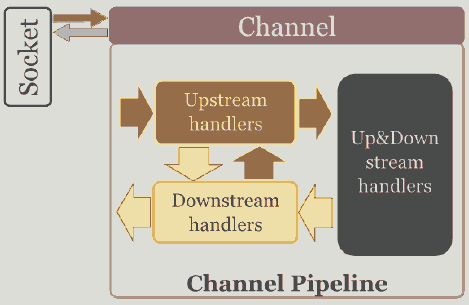
CHANNELPIPELINE是关键,它类似Unix的管道,有以下作用:
为每个Channel 保留 ChannelHandlers ,如EchoServerHandler
所有的事件都要通过它
不断地修改:类似unix的SH管道: echo "Netty is shit...."
| sed -e 's/is /is the /'
一个Channel对应一个 ChannelPipeline
包含协议编码解码 安全验证SSL/TLS和应用逻辑
客户端代码
前面我们演示了服务器端代码,下面是客户端代码:
public class
EchoClient {
private final String host;
private final int port;
private final int firstMessageSize;
public EchoClient(String host, int port, int
firstMessageSize) {
this.host = host;
this.port = port;
this.firstMessageSize = firstMessageSize;
}
public void run() throws Exception {
// Configure the client.
EventLoopGroup group = new NioEventLoopGroup();
try {
Bootstrap b = new Bootstrap();
b.group(group).channel(NioSocketChannel.class)
.option(ChannelOption.TCP_NODELAY, true).handler(new
ChannelInitializer<SocketChannel>() {
@Override
public void initChannel(SocketChannel ch) throws
Exception {
ch.pipeline().addLast(
// new LoggingHandler(LogLevel.INFO),
new EchoClientHandler(firstMessageSize));
}
});
// Start the client.
ChannelFuture f = b.connect(host, port).sync();
// Wait until the connection is closed.
f.channel().closeFuture().sync();
} finally {
// Shut down the event loop to terminate all
threads.
group.shutdownGracefully();
}
}
} |
客户端的应用逻辑EchoClientHandler:
public class
EchoClientHandler extends ChannelInboundHandlerAdapter
{
private static final Logger logger = Logger.getLogger(EchoClientHandler.class.getName());
private final ByteBuf firstMessage;
/**
* Creates a client-side handler.
*/
public EchoClientHandler(int firstMessageSize)
{
if (firstMessageSize <= 0) {
throw new IllegalArgumentException("firstMessageSize:
" + firstMessageSize);
}
firstMessage = Unpooled.buffer(firstMessageSize);
for (int i = 0; i < firstMessage.capacity();
i++) {
firstMessage.writeByte((byte) i);
}
}
@Override
public void channelActive(ChannelHandlerContext
ctx) {
ctx.writeAndFlush(firstMessage);
System.out.print("active");
}
@Override
public void channelRead(ChannelHandlerContext
ctx, Object msg) throws Exception {
ctx.write(msg);
System.out.print("read");
}
@Override
public void channelReadComplete(ChannelHandlerContext
ctx) throws Exception {
ctx.flush();
System.out.print("readok");
}
@Override
public void exceptionCaught(ChannelHandlerContext
ctx, Throwable cause) {
// Close the connection when an exception is
raised.
logger.log(Level.WARNING, "Unexpected exception
from downstream.", cause);
ctx.close();
}
} |
|